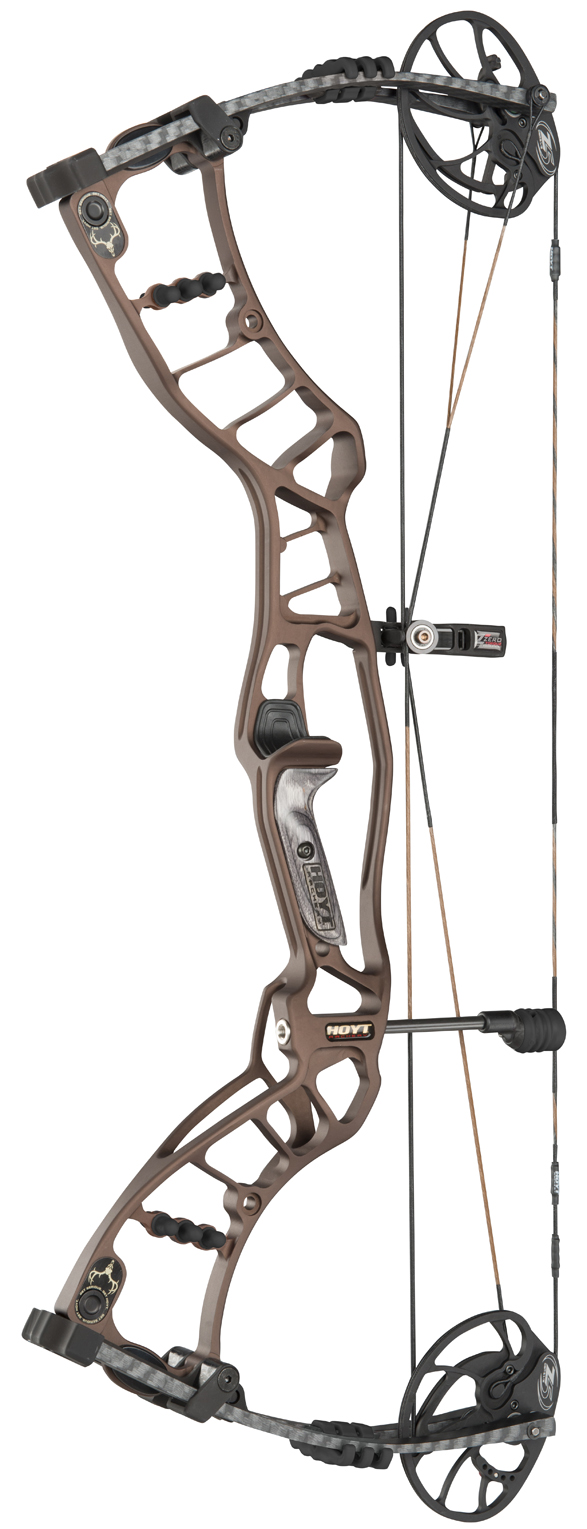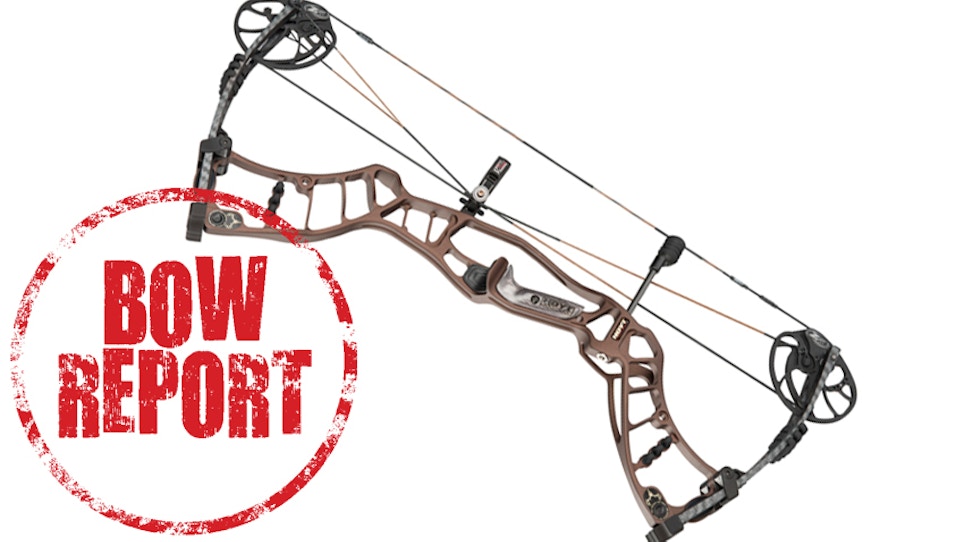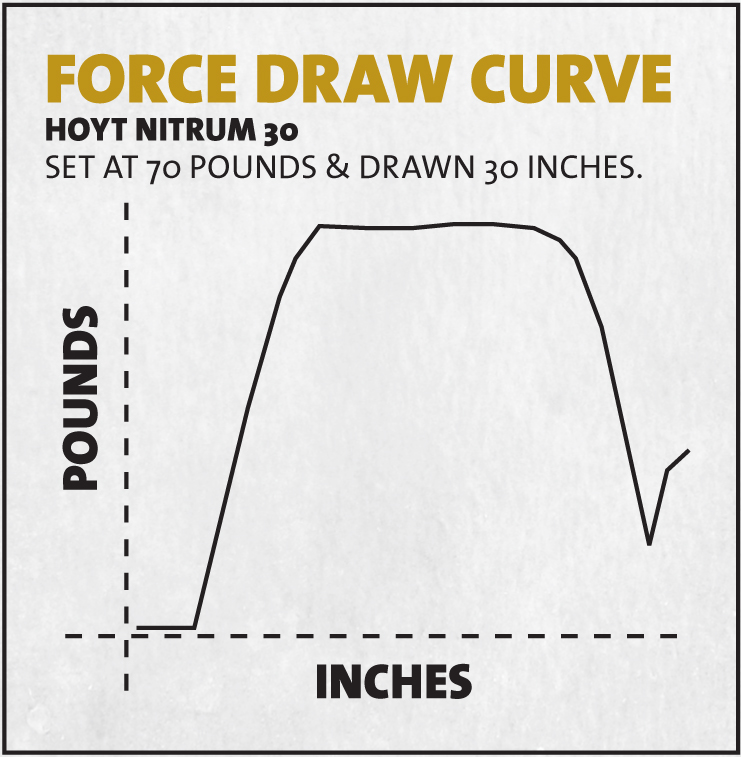The Nitrum 30 is one of four Nitrum bows in Hoyt’s 2015 lineup. Essentially an aluminum riser counterpart to Hoyt’s Carbon Spyder series bows, the Nitrum bows share much of the same technology as the carbon bows, including the Z5 Cams (or the Turbo Cam, in some cases), the now familiar (though improved for 2015) AirShox, the ZT Cable Guard System, the wood grip and Silent Shelf, and even the same XTS Pro Arc Limbs with the distinctive Pro-Lock limb-pocket design.
Hoyt’s designers seem particularly proud of the ZT (Zero Torque) cable guard. It is in fact an ingenious design that counteracts torque with a reverse mounting that directs side tension from cables in the opposite direction.
The obvious difference between the two series is the aluminum vs. carbon riser, and for 2015, Hoyt has taken an excellent aluminum riser and made it even better. While the new riser retains the characteristic Hoyt bridge behind the grip and the offset stabilizer bushing, the overall design is very different, featuring what Hoyt calls a “tunnel” on the lower part of the riser (which might be thought of as a bridge on a different plane). In fact, the entire riser is built on different planes, curving or twisting slightly at strategic locations. The result is a stronger, super-stiff riser that significantly reduces any noise or vibration and provides a super-rigid shooting platform.
Fit and finish were excellent on the test bow, though some machining was visible around the small Allen bolt that secures the string stopper. Overall the design changes to the riser make for a curvier, less geometrical and (I think) great-looking bow.
Shooting the Bow
At 3.9 pounds the Nitrum 30 is nearly as light as most of its carbon counterparts and in fact is a shade lighter than the Carbon Spyder ZT Long Draw. It’s noticeably well-balanced, with less of a top-heavy feel than most compact bows, and the offset stabilizer bushing contributes to the balance when a stabilizer is used.
Hoyt recommends setting centershot at between 1 inch and 15⁄8 inches, a surprisingly wide margin. I found that aligning the arrow with the string was a good starting point, though I tweaked it a few times to get perfect arrow flight. Vertically, squaring the arrow to the string worked well.
I’m not the first to remark that the Z5 Cam and ½ System is exceptionally smooth. It draws back steadily, dropping off from peak weight gradually to a firm stop with no sense of any jumps or bumps along the way. At 75 percent letoff, the valley is comfortable but not overly wide; there is neither a sense of grabbiness nor the feeling that the arrow almost has to be pushed to let down from full draw. At the shot the bow pops forward slightly into the hand, with a negligible tuning fork sensation (at least with a stabilizer in place). The wood grip is more than comfortable and was especially welcome given that the subjective portions of testing the bow were done in bitter-cold conditions.
Though it’s not new, I’m a believer in Hoyt’s Silent Shelf design. Not only does it deaden the sound of arrows or fall-away rests clacking the shelf, but the extended lip gives me an extra measure of confidence when I’m drawing a razor-sharp broadhead back to a point where it’s all but touching my hand.
Earlier I made reference to the Nitrum 30’s weight in comparison to that of the Carbon Spyder bows. The speed, too, is comparable between the various Nitrum bows and the Carbon Spyder bows and, not surprisingly given all the shared technology, the feel when shooting the bows is very similar. The question becomes, what does a shooter give up when selecting an aluminum riser Nitrum bow vs. a carbon riser Carbon Spyder bow?
The performance of the aluminum riser bows is, in most important respects, virtually the same as that of the carbon series bows, and some shooters may prefer the aluminum bows. At about $950, the Nitrum bows are hardly cheap, though they still sell for about $250 less than Hoyt’s high-end carbon series bows. Perhaps the great thing for Hoyt and Hoyt’s many loyal customers is that shooters who prefer the aluminum bows, as well as the shooters who would simply prefer to save a little money, can pick up a Nitrum series bow with absolutely no sense that they are settling for less than the best.
Hoyt Nitrum 30 Specs
Letoff:……………………… 75%
Brace Height:………………6.75 inches
Weight:…………………….. 3.9 pounds (approximate)
Axle-To-Axle Length:…….. 30 inches
Speed:……………………… 332 fps
Draw Lengths:…………….. 24-25.5 inches, 26-28 inches, 28-30 inches, adjustable in half-inch increments
Draw Weights:…..………… 40, 50, 60, 65, 70 and 80 pound peak, adjustable down 10 pounds from peak.
Options:…………………… Black Out, Realtree Max-1, Realtree Xtra, numerous custom hunting and target finishes
Suggested Retail:………… $950
Objective Tests (30 Inches Draw)
Peak Hold*:…………………70 pounds
Weight, Full Draw*:………17.5 pounds
*Rounded to nearest half-pound
At 70-Pound Draw Weight
| Arrow Weight | Speed @ Launch | Speed @ 20 Yards | K.E. @ Launch | K.E. @ 20 Yards |
| 385 grains | 307 fps | 296 fps | 80.5 ft. lbs. |
75 ft. lbs. |
| 500 grains | 279 fps | 270 fps | 86.5 ft. lbs. | 81 ft. lbs. |
At 60-Pound Draw Weight
| Arrow Weight | Speed @ Launch | Speed @ 20 Yards | K.E. @ Launch | K.E. @ 20 Yards | Sound Level |
| 385 grains | 286 fps | 278 fps | 70 ft. lbs. | 66 ft. lbs. | 58.6 dBA |
| 500 grains | 258 fps | 254 fps | 74 ft. lbs. | 71.5 ft. lbs. | 46.6 dBA |







